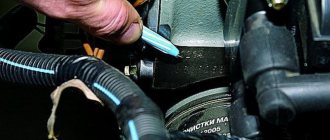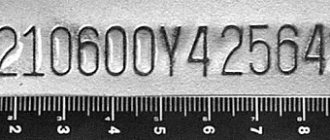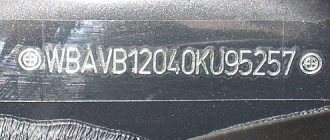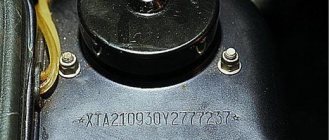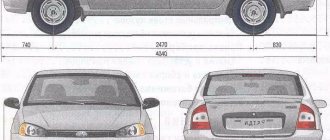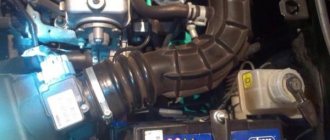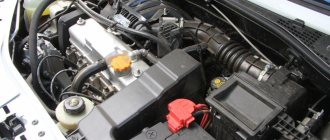Location of unit identification numbers and their designations, VIN number
On the right central pillar, below, there is a double plate with information about the car.
Explanation of the designations on the bottom plate : 1 – AVTOVAZ – manufacturer; 2 – vehicle type number (vehicle approval type). In the structure of the vehicle type approval number indicated on the manufacturer's plate, extension, extension or correction indices (P1, P2, P1, P2, I1, I2, etc.) are not indicated. To determine the full vehicle type approval number, you should be guided by the information specified in the vehicle passport. 3 – identification number (VIN number) ; 4 – permissible maximum weight; 5 – permissible maximum weight of a vehicle with a trailer equipped with a brake system; 6 – maximum permissible load on the front axle, kg; 7 – maximum permissible load on the rear axle, kg
9 - Number for spare parts. 10 — Engine designation. 11 — Commercial designation of the vehicle.
Decoding VIN number
According to international standards, the first three letters indicate the manufacturer's code; The next six characters are the car model; letter of the Latin alphabet (or number) - model year of the car; the last seven digits are the chassis number, which for a passenger car corresponds to the body number. In accordance with the Technical Regulations “On the Safety of Wheeled Vehicles”, the model year is defined as a conditional year indicated by the manufacturer (usually following the actual year of manufacture of the vehicle). At AVTOVAZ, the start of the model year is set on July 1 of the calendar year. Thus, from January 1 to June 30, the model year corresponds to the actual year of manufacture of the car, and from July 1 to December 31 corresponds to the one following the actual year of manufacture of the car.
The VIN number is also located (duplicated) under the front passenger seat, on the body cross member
Engine number location
The location of the label depends on the installed engine.
The red arrow indicates the location of the engine number.
Location of numbers on the engine (1.6 l)
This photo shows the engine number with the heat shield removed.
Attention: car enthusiasts note the fact that the location and method of applying the number in this place is unsuccessful. Over 100 thousand km. mileage (in Russian conditions) due to corrosion, this number becomes completely unreadable . This may create problems when re-registering the car. It is recommended that measures be taken to protect this label.
Engine 11189
Engine 21129
1 — The first five digits are the engine model index. 2 - Seven digits: limited by stars - serial production number of the engine.
Engine K4M
1 — The first three numbers are the engine type (K4M). 2 - The following four characters are an option for the manufacturer. 3 — Engine serial number.
Difference in manufacturer designation
Production AVTOVAZ
Marking of K4M assemblies of AVTOVAZ assembly with the letter “P”
The location of the sticker with the gearbox code can be seen here
Video
Source
Engine options
K4M has several modifications with different characteristics. Thus, the 16-valve K4M Renault Megane 2 engine has the digital designation 812 (K4M812). Models differ in markings. As with all Renault engines, the rule applies here:
A block of three numbers - coding the features of the motor (power, gearbox type, etc.), for example, an even number indicates the purpose of the power unit for assembly with a manual transmission, an odd number - with an automatic transmission.
Thus, the K4M Renault engine with code 812 is a motor with an aluminum head, gasoline, 4 cylinders and 16 valves, 1.6 liters in volume, for manual transmissions.
Source
Where is the engine number on Largus
Stealing a Lada Largus is a pretty funny idea, so knowledge of the location of forensic markings is only necessary in order not to make a mistake when checking the traffic police registration numbers. The main VIN number is located where air conditioning condensation sometimes reaches - a strip under the front passenger seat:
The duplicate sticker is located on the right central pillar, you should see it when you open the door in search of the main VIN. If it is not there or it is quite damaged, which often happens with Largus, then problems are likely during reconciliation:
Before buying a used car, it is very advisable to check the VIN registered in the ECU units:
What does largus mean?
Review of the Lada Largus
In Latin the word largus means
"generous".
AvtoVAZ says that this word became the basis for the name of the new model. ... The Lada Largus
is a licensed copy of the Dacia Logan MCV. The model was developed jointly with the Renaul-Nissan concern.
Interesting materials:
Do I need to putty the walls before laying the tiles? Do I need to putty the walls under wallpaper before painting? Do I need to putty the walls under wallpaper? Is it necessary to putty the walls after gypsum plaster under the wallpaper? Do I need to putty the walls after gypsum plaster? Do I need to putty the walls after plastering under the wallpaper? Do I need to putty the walls? Do I need to putty? Do I need to plaster a concrete ceiling? Is it necessary to plaster the foam block?
Vehicle registration details
At the bottom of the front passenger door pillar there is a manufacturer's plate that contains information about the vehicle.
The designations at the bottom of the plate are deciphered as follows:
: 1 – manufacturing plant; 2 – vehicle type approval number; 3 – vehicle identification number (VIN); 4 – permissible maximum vehicle weight; 5 – permissible maximum weight of a vehicle with a trailer equipped with brakes; 6 – maximum permissible load on the front axle, kg; 7 – maximum permissible load on the rear axle, kg
The vehicle identification number (VIN) is located on the body cross member under the front passenger seat. The model and engine number are printed on the boss of the front wall of the cylinder block, next to the oil pressure indicator sensor.
Location of engine number 1.6 (16V)
For clarity, the location of the engine number 1.6 (16V) is shown on the dismantled engine
Location of engine number 1.6 (8V)
For clarity, the location of engine number 1.6 (8V) is shown with the exhaust manifold heat shield removed
On the first Largus, the engine was still Spanish, then these engines began to be assembled in Russia, and a long time ago, after buying the second Largus, I was 100% sure that the engine was our assembly, but now I decided to check and was very surprised, the engine is Spanish! Number starts with D
the letter in the engine number is the manufacturer's code. D
An addition to the basic information for the K4M K is the engine range, which determines the crankcase material, the type of cylinder liners, the number of cylinders and crankshaft supports. 4 - head type, valve location. M is the approximate working volume. (in our case from 1576 to 1650) Next is the suffix. These are the letters/numbers after the engine type. The first digit (if 6, 7, or af - then the engine was manufactured at Renault factories. The last digit - even - means that the engine is designed for mechanics. - not even - for automatic transmission. If the suffix contains the letter S (for example S 0000) - this indicates that the engine has been overhauled or assembled from parts of other engines.
Next, the cooling system and drive belts. Recommended product for the TOTAL GLACEOL RX cooling system. Not available for free sale. TOTAL GLACELF AUTO SUPRA is produced as a direct analogue for the wide market. Thermostat opening temperature = 83 degrees. 2-speed fan. 1 speed = turns on at 99 degrees, turns off at 96 degrees. Speed 2 = turns on at 102 degrees, turns off at 99 degrees. Constant operation of the fan indicates that the temperature sensor is faulty and the fans have gone into emergency mode.
OIL LEVEL IS NOT LOWER OR ABOVE THE REQUIRED LEVEL!
Excessive amount of oil in the engine leads to an increase in the amount of crankcase gases - this leads to coking of the throttle valve in the engine intake tract.
K4M engine structure
The K4M engine of Renault Fluence and other models is distinguished by its simplicity of design and good build quality. The motor operates well under load regardless of ambient temperature.
crank mechanism
The pistons are made of light alloy. To prevent the working mixture from entering the crankcase and oil from entering the cavity of the working cylinder, compression and oil scraper rings are installed on the piston. In the area of the compression rings, the piston is reinforced with a steel insert.
The pistons are connected to the crankshaft by connecting rods. Sliding bearings are installed at the bottom of the connecting rod. They have holes for supplying oil under pressure to the crankshaft journals.
The piston is connected to the connecting rod using a metal pin. It is firmly pressed into the upper hole of the connecting rod.
Gas distribution mechanism
The K4M Renault engine has a 16 V gas distribution mechanism. This means that there are two intake and 2 exhaust valves for each cylinder. The valve mechanism is controlled using two camshafts. Torque is transmitted to the camshafts using a belt from the crankshaft.
IMPORTANT: When the gas distribution mechanism belt breaks, the pistons deform the open valves. To avoid deformation, it is necessary to check the drive belt for damage and, if necessary, replace it.
A distinctive feature of the engine is the different lengths of the valves of the gas distribution mechanism. The intake valves are 1.68 mm longer than the exhaust valves. Thanks to the installed hydraulic compensators, there is no need to adjust the thermal gap.
Cooling
The 16 valve engine of the Lada Largus K4m has a forced-type liquid cooling system. The liquid used in the system is antifreeze or antifreeze. The cooling system is sealed. To avoid leakage as a result of pressure when the power unit heats up, an expansion tank is provided.
For quick warm-up in the winter, a thermostat is included in the cooling system. It blocks a large circulation circle at low coolant temperatures. When the required coolant temperature is reached, the thermostat opens a large circulation circle.
The movement of the working fluid in the cooling system is carried out using a centrifugal water pump. It is driven by a pulley mounted on the engine crankshaft.
A radiator is provided to cool the working fluid. Under the influence of the pump, antifreeze enters the upper radiator tank. After this, the liquid flows through the radiator honeycomb. The antifreeze in the radiator is cooled by air passing through the honeycombs. Forced air movement is carried out by a fan.
Summing up
The presented reviews about the main Largus engines - the 8-valve VAZ 11189 and the foreign 16-valve engine - indicate that for full-fledged dynamics the car needs a slightly more powerful engine. Perhaps the engineers intended a calm and obedient car, but in reality it turned out to be very sluggish.
The weakness of the engines, even the 16-valve version, is evidenced by the fact that they consume fuel a little more than stated. Almost everyone complains about this. For comparison, you can take Kalina 2 from the first review with the same 8-valve engine. According to the user, he walks confidently and dynamically, which Largus lacks.
You can apply tuning to both engines, but this is an additional cost. In addition, the warranty on a new car will be void. It’s easier to buy another car and not have to worry about it. Although some people like to tinker with hardware. The 8-valve engine can be throttled from environmental control, and the 16-valve engine, in general, has wide chip tuning capabilities that allow you to increase the power to 150 hp. With.
In a station wagon
Replacing the body on a Lada Kalina
Today, many experts see the station wagon as the best creation of the Kalina family. Indeed, although its exterior is not distinguished by noticeable and catchy solutions, in order to appeal to a certain caste of consumers, it is an ideal vehicle of the classic type.
Initially, the designers were given the goal of inventing and constructing a car that would meet the needs of the masses. It was supposed to become a universal vehicle for every day. Both men and women had to like the car.
Regarding body production technology:
Among other advantages of the body, we can highlight the large spaciousness of the interior and luggage compartment. This, in turn, was achieved due to a successful layout solution aimed solely at increasing the volume of internal space. In addition, the car was designed with a high seating position, which provided good visibility.
Regarding comfort:
Lada Kalina station wagon
Regarding driving performance:
Thanks to the successful combination of body and suspension, good handling and maneuverability appeared. The station wagon is comfortable to drive, both in the city and outside it.
Where is the engine number on Lada Largus?
On the first Largus, the engine was still Spanish, then these engines began to be assembled in Russia, and a long time ago, after buying the second Largus, I was 100% sure that the engine was our assembly, but now I decided to check and was very surprised, the engine is Spanish! Number starts with D
the letter in the engine number is the manufacturer's code. D
An addition to the basic information for the K4M K is the engine range, which determines the crankcase material, the type of cylinder liners, the number of cylinders and crankshaft supports. 4 - head type, valve location. M is the approximate working volume. (in our case from 1576 to 1650) Next is the suffix. These are the letters/numbers after the engine type. The first digit (if 6, 7, or af - then the engine was manufactured at Renault factories. The last digit - even - means that the engine is designed for mechanics. - not even - for automatic transmission. If the suffix contains the letter S (for example S 0000) - this indicates that the engine has been overhauled or assembled from parts of other engines.
For those who intend to buy a K4M model engine, this is a must-read!
Know that any 16-valve engine is very sensitive to the choice and quality of oils. The engine in Largus at the plant is filled with imported material:
- SHELL PC 1448, 0W30
- ELF SOLARIS RNX, 5W30
At one time, LUKOIL Genesis RN oil was used, the viscosity of which corresponds to the 5W40 class. We have already written in more detail about choosing oil for a 16-valve engine here.
What “they” use as “5W30” is called “5W40” by us.
The oil filter, if we talk about 16 valves, also has strict requirements. And with an 8-valve valve everything looks simpler: the choice of oils has 20 options, and the filter can be changed “every time” (but this is already against the regulations).
Two features of the Renault engine
The reader may have noticed that K4M engines require more oil and low-temperature oil must be poured into it: 0W is for temperatures “lower than minus 35”. The bottom line is that the engine really has problems with winter starting. But it also has a phase regulator to provide better traction at the bottom.
Gear phase regulator in Renault two-shaft internal combustion engines
On VAZ-11189 engines there is no phase adjustment system.
For Largus station wagons, the K4M engine was modified: the phase regulator was replaced with a regular gear. Be aware of this!
Hydraulic compensators mounted on the valve lifters make the K4M engine silent. In general, the combination of “cast iron block + hydraulic compensators” is more typical for limousines. So consider that Largus with 16 valves is a limousine. Requiring attention, quality service and expensive materials.
Hydraulics kit for K4M
Renault Logan 2 – Engine number K4M, K7M, H4M
However, the main problem lies under the hood. Owners of previous Logans know how easily and quickly engine numbers rot on their engines. In 3-4 years, the symbols could not only become covered with a coating of corrosion, but disappear forever without a trace, so that neither WD-40 nor zinc lotions could help. The second generation did not lose this drawback, but the rate of destruction clearly decreased sharply. It is especially dangerous to clean the markings with sandpaper. Let me remind you that the law contains an article for the deliberate destruction of forensic markings. Fortunately, the new amendments allow you to re-register a car with a rotten license plate. Not without unnecessary movements, of course, but it’s possible.
On the K4M (1.6, 103 hp) and K7M (1.6, 82 hp) Logan 2 power plants, the engine number is located in almost the same place: in the front of the unit, under the manifold, closer to the gearbox. In the case of a 16-valve unit, it is extremely difficult to establish visual contact with the platform, even with an inspection mirror. In order to clean the symbols from rust, you will have to completely dismantle part of the air duct, otherwise a hand with a rag will not fit through.
The only engine with which there will definitely be no problems with corrosion and dirt is the Nissan H4M unit (113 hp). The engine number on it is printed vertically on an inclined platform in the front of the engine close to the gearbox:
Renault Logan 2 – Weaknesses and breakdowns
VIN code
1. The identification number (VIN) is stamped on the floor under the front passenger seat on the right side. To inspect the room, a valve has been cut out of the carpet. The VIN code is also duplicated on the wall between the engine compartment and the engine.
Depending on the configuration of the Lada XRAY, there may be a glove box under the passenger seat. In this case, to access the number, you must fully extend the movable part of the glove box by pulling the stops outward on both sides.
2. The marking (nameplate) is located on the right pillar, below, near the threshold.
It indicates the model, car number, engine model, weight data, number for spare parts, design options, and configurations. Explanation:
- Manufacturer's name OJSC AVTOVAZ (AVTOVAZ).
- Vehicle type approval number. It is given in full in the vehicle passport.
- Vehicle identification number VIN.
- Technically permissible maximum vehicle weight.
- Technically permissible maximum weight of a road train.
- Technically permissible maximum axle weight on the front axle.
- Technically permissible maximum axle weight on the rear axle.
- Vehicle designation.
- Engine designation.
- Number for spare parts. The number for spare parts corresponds to the serial number of the vehicle leaving the assembly line. When ordering spare parts, you must refer to the information contained on the identification plate.
- Market circulation sign.
Let us recall that in accordance with the Decision of the Customs Union Commission dated June 15, 2011 No. 711, the model year is defined as a conditional year indicated by the manufacturer (usually following the actual year of manufacture of the vehicle).
At JSC AVTOVAZ, the start of the model year is set on July 1 of the calendar year. Thus, from January 1 to June 30, the model year corresponds to the actual year of manufacture of the car, and from July 1 to December 31 corresponds to the one following the actual year of manufacture of the car.
Advantages and disadvantages of Lada Largus
The main advantage of the Lada Largus is practicality and spaciousness. Proper placement of seats ensures comfort for the driver and front passenger. The dashboard is easy to use, the instrument cluster is easy to read. The tailgates are equipped with pockets for small items.
Among the shortcomings are poor sound insulation, the location of the spare tire under the bottom, which reduces ground clearance, a limited set of functions as standard - no ABC, no front electric windows. The signal button is located “in the French style” on the steering column lever, which is unusual for Russian drivers. The view from the driver's seat is slightly impaired by the right front pillar, which covers part of the exterior mirror.
Foreign media call Lada Largus the new flagship of AvtoVAZ. It took about four years to achieve such success. During this time, the company was able to modernize even production to meet the needs of Russian-assembled foreign cars. Today, the level of localization of auto components has been increased to 50%, and in the future this figure is planned to be increased to 80%.
Engine Lada Largus 8 valve characteristics, dynamics, fuel consumption
Lada Largus 8 valves is the most affordable option for a practical station wagon. Initially, the model was equipped with an 8-valve engine from the Renault K7M series of the same displacement of 1.6 liters. True, the previous power unit had to be imported from Romania, which, given the fall of the ruble, turned out to be simply unprofitable, so the manufacturer switched to the domestic analogue of the VAZ-11189.
Gasoline power unit Lada Largus VAZ-11189 with a power of 87 hp. with a displacement of 1.6 liters, it replaced the VAZ-11183 injection engine developing 82 horsepower. The new lightweight piston group from Federal Mogul managed to increase the power and efficiency of the power unit. Of course, the engine is not distinguished by enchanting dynamics and low fuel consumption, but its relatively simple design and maintainability allow us to talk about a good option for our harsh operating conditions.
As for the technical part, it is based on a cast-iron cylinder block, an aluminum head, an aluminum cylinder head cover, and a steel engine sump. In the timing drive Lada Largus 8-cl. there is a belt. The eight-valve timing mechanism does not have hydraulic compensators; valve adjustment occurs rarely, but the process is quite painstaking. It is necessary to select “nickels” of different thicknesses and place them between the camshaft cams and the bottoms of the pusher cups. The first time such a procedure is carried out is at the so-called “0” maintenance after 3000 km.
The age-old question : Do the valves on the Largus VAZ-11189 engine bend when the timing belt breaks? The answer is clear: when the valve belt breaks, it bends! The engine is paired with a 5-speed manual transmission; no other options are provided.
Below are the technical characteristics of the base Lada Largus engine 8 valves 87 hp.
Engine Lada Largus 1.6 (87 hp), fuel consumption, dynamics
- Working volume – 1597 cm3
- Number of cylinders/valves – 4/8
- Timing drive - belt
- Cylinder diameter – 82 mm
- Piston stroke – 75.6 mm
- Power hp/kW – 87/64 at 5100 rpm
- Torque – 140 Nm at 3800 rpm
- Maximum speed – 158 kilometers per hour
- Acceleration to the first hundred – 14.4 seconds
- Fuel consumption in the city – 10.6 liters
- Fuel consumption in the combined cycle – 8.2 liters
- Fuel consumption on the highway - 7.6 liters
the use of AI-92 gasoline as fuel .
Engine
LADA LARGUS cars are equipped with gasoline, in-line, 4-cylinder, 8- and 16 - valve engines with a displacement of 1.6 liters. with 2 or 4 valves per cylinder.
For engine identification number plate locations, see here. The ratio of installed engines and gearboxes in trim levels can be found here.
Until mid-2016, the car was equipped with Renault K7M (8-cl) and K4M (16-cl) engines. Since 2016, their modern analogues produced by AvtoVAZ began to be installed. Accordingly, the K7M was replaced by the VAZ-11189 , and the K4M was replaced by the VAZ-21129 . The engines are distinguished by a lightweight ShPG, automatic timing belt tensioner, metal cylinder head gasket, body kit and supports.
Since 2022, Lada Largus CNG (with LPG) will be equipped with 21129 CNG dual-fuel engines.
Depending on the vehicle configuration, there are several options for installing auxiliary equipment on engines:
- a car with power steering;
— a car with non-power steering and air conditioning;
— a car with hydraulic power steering;
— a car with hydraulic power steering and air conditioning.
The main parameters and characteristics of the engines are given in tables 1 and 2.
| External delivery Marking of K4M units for external delivery (for example, “D”) | ||
| Options | Engine model | |
| RENAULT, K4M | RENAULT, K7M | |
| Injection type | Electronically controlled multipoint fuel injection | |
| Fuel type | Gasoline Premium-95 GOST 51105-97 | |
| Number and arrangement of cylinders | 4, in-line | |
| Number of valves | 16 | 8 |
| Cylinder operating order | 1-3-4-2 | |
| Direction of rotation of the crankshaft (from the camshaft drive mechanism side) | ||
| right | ||
| Cylinder diameter/piston stroke, mm | 79,5×80,5 | |
| Working volume, cm 3 | 1598 | |
| Compression ratio | 9,8 | 9,5 |
| Toxicity standards | Euro 4 | |
| Power at 5500 rpm, kW (hp) | — | 62 (84) |
| Power at 5750 rpm, kW (hp) | 77(105) | — |
| Maximum torque, N.m (at rpm) | 148 (3750) | 124 (3000) |
| Volume of oil poured into the engine lubrication system, including oil filter, l | 4,8 | 3,3 |
| Options | Engine model | |
| VAZ 11189 | VAZ 21129 | |
| Engine volume, cm3 | 1596 | 1596 |
| Number and arrangement of cylinders | 4, in-line | 4, in-line |
| Number of valves | 8 | 16 |
| Maximum power, kW (min") | 64*(5100) | 78*(5800) |
| Maximum torque, N*m (min*1) | 140*(3800) | 148*(4200) |
| Cylinder diameter, mm | 82 | 82 |
| Piston stroke, mm | 75,6 | 75,6 |
| Compression ratio | 10,3 | 10,45 |
| Injection type | Electronically controlled multipoint fuel injection | |
| Octane number of gasoline | At least 92 | At least 92 |
| Transmission | Mechanical 5-speed | |
| Gearbox designation | JR5, 21809 | |
| Wheel drive | 4×2 | |
| Drive wheels | Front | |
| Environmental class | 5 | |
| Engine weight | ≈111.0 kg | 110.7 kg |
Engine manufactured by AVTOVAZ 1.6 l.
ENGINE 1.6 (8 valve, 84 hp)
The K7M engine is a gasoline, four-stroke, four-cylinder, in-line, eight-valve, overhead camshaft. The operating order of the cylinders is: 1–3–4–2, counting from the flywheel. Power supply system – distributed fuel injection (emission standards Euro 4).
The engine, gearbox and clutch form the power unit - a single unit mounted in the engine compartment on three elastic rubber-metal supports. The right support is attached to the bracket on the top cover of the gas distribution mechanism drive, and the left and rear ones are attached to the gearbox housing. On the front of the engine (in the direction of vehicle movement) there are: exhaust manifold, oil filter, low oil pressure warning sensor, coolant pump supply pipe, spark plugs, generator, power steering pump, air conditioning compressor.
At the rear of the engine there are: an intake manifold with absolute pressure and intake air temperature sensors, a throttle assembly with a throttle position sensor and an idle speed regulator, a fuel rail with injectors, a knock sensor, a starter, and an oil level indicator. On the right is the coolant pump, timing gear and coolant pump drive (toothed belt), auxiliary drive drive (V-ribbed belt). On the left are: flywheel, thermostat, crankshaft position sensor, coolant temperature sensor. On top is the ignition coil, oil filler neck. The engine cylinder block is cast from cast iron, the cylinders are bored directly into the block. At the bottom of the cylinder block there are five crankshaft main bearing supports with removable caps, which are attached to the block with special bolts. The holes in the cylinder block for the bearings are machined with the covers installed, so the covers are not interchangeable and are marked on the outer surface to distinguish them (the covers are counted from the flywheel side). On the end surfaces of the middle support there are sockets for thrust half-rings that prevent axial movement of the crankshaft.
The crankshaft main and connecting rod bearing shells are made of steel, thin-walled, with an anti-friction coating applied to the working surfaces. Crankshaft with five main and four connecting rod journals. The shaft is equipped with four counterweights, integral with it. The counterweights are made on the continuation of the “cheeks” of the engine crankshaft. Counterweights are designed to balance the forces and moments of inertia that arise during the movement of the crank mechanism during engine operation. To supply oil from the main journals to the connecting rods, there are channels made in the journals and cheeks of the shaft. At the front end (toe) of the crankshaft there are installed: an oil pump drive sprocket, a timing gear drive pulley and an auxiliary drive pulley. The toothed pulley is fixed on the shaft with a protrusion that fits into a groove on the toe of the crankshaft and protects the pulley from turning. The auxiliary drive pulley is similarly fixed on the shaft.
The connecting rods are steel, I-section, processed together with the covers. The covers are attached to the connecting rods with special bolts and nuts. The piston pin is steel, tubular in section. The pin, pressed into the upper head of the connecting rod, rotates freely in the piston bosses. The piston is made of aluminum alloy. The piston skirt has a complex shape: barrel-shaped in the longitudinal section, oval in the transverse section. In the upper part of the piston there are three grooves machined for piston rings. The two upper piston rings are compression rings, and the lower one is oil scraper. Compression rings prevent gases from escaping from the cylinder into the engine crankcase and help remove heat from the piston to the cylinder. The oil scraper ring removes excess oil from the cylinder walls as the piston moves.
ENGINE 1.6 (16 valve, 105/102 hp)
The K4M engine is a gasoline, four-stroke, four-cylinder, in-line, sixteen-valve, with two overhead camshafts. The operating order of the cylinders is: 1–3–4–2, counting from the flywheel. Power supply system – distributed fuel injection (emission standards Euro 4). The engine, gearbox and clutch form the power unit - a single unit mounted in the engine compartment on three elastic rubber-metal supports. The right support is attached to the upper cover of the gas distribution mechanism drive, and the left and rear ones are attached to the gearbox housing.
General recommendations for engine maintenance
Note: The information below is for general information purposes only and is not specific to any car brand.
Fortunately, automakers understand that in the world there are not only developed countries like the USA, Germany, Japan, France, etc., but also developing countries like Iran, Nigeria, Angola, Sudan, and now Russia, so cars, those supplied there are often very different from promising technology, and, according to our realities, for the better.
This entire preface was written for a reason. If we are talking today about the health of the engine and its longevity, then the first item on the agenda will, of course, be the choice of the power unit, so that then we can simply carry out scheduled maintenance without any repairs, replacement of components, vessels with warranty departments of dealer organizations and other similar inconveniences that are common drag on for a very long time, especially in our country.
Video
Source
Torque of both engines (comparison)
Let's try to answer the question which engine in the Lada Largus is the most powerful. It will be easy to find the answer if you analyze the torque graph.
Again we get a paradox:
- At idle the force is 100 N*m;
- Then both graphs grow linearly. However, the Renault engine turns out to be more torquey, since at 2000 rpm it develops 135 N*m, and not 130, like the VAZ engine. Alas and ah.
Everyone is accustomed to the fact that at low speeds an 8-valve engine should “pull” better. Perhaps everything will be so, if you do not compare the engines of two different companies. Draw conclusions.
Timing diagram Lada Largus 8 valves
- 1 - crankshaft toothed pulley
- 2 - coolant pump toothed pulley
- 3 - tension roller
- 4 - rear protective cover
- 5 - camshaft gear pulley
- 6 - timing belt
- A - boss on the rear protective cover
- B - mark on the camshaft pulley
- C - mark on the oil pump cover
- D - mark on the crankshaft pulley.
Another feature of the engine is the location of the water pump (pump), which is rotated by the same timing belt. That is, in case of coolant leaks or characteristic noise/whistle/hum in the timing drive area, checking the belt is mandatory. If the pump bearing crumbles and the belt comes off, then in addition to replacing the water pump housing and belt, you will also have to go through the cylinder head, removing bent valves from there.
AvtoVAZ uses a very reliable Gates belt as the original belt. Often the service life of the Gates belt is much higher than the service life of the pump and tension pulley of the Lada Largus 8-valve engine.
Device and characteristics
The engine marked K4M is a high-tech power unit with high performance. The first production of the power unit began back in 1999. The motor design is quite simple and understandable. The only difference from its younger brother K7M is that there are two camshafts in the cylinder head.
Also, the engine is much quieter because hydraulic compensators are installed. The engine is equipped with sixteen valves, which increases power characteristics and slightly reduces fuel consumption. The average engine life is 350,000 - 400,000 km.
Main technical characteristics of K4M
| Name | Index |
| Manufacturer | Renault |
| Volume | 1.6 liter (1598 cc) |
| Number of cylinders | 4 |
| Number of valves | 16 |
| Fuel | Petrol |
| Injection system | Injector |
| Power | 102 hp |
| Fuel consumption | 7.9 l/100 km |
| Cylinder diameter | 79.5 mm |
| Econorm | Euro 4 |
The French engine was also equipped with gearboxes from Renault cars with JR5 or JH3 markings, which were also installed on Logan.
Engines for Largus
The body is a body, but the car must be driven by something. The manufacturer did not reinvent the wheel and installed engines from Logan on Largus:
But, there is a domestic development, the engine from Vesta - VAZ 11189. It is also installed on Largus. In fact, this is an engine from Granta, only converted to Euro 5 standards.
We are interested in the last 2 engines: the French one with 16 valves and ours with 8 valves. It’s interesting to know what reviews car enthusiasts write about Largus with a VAZ engine. And of course, compare them with reviews of a foreign-made 16-valve engine.
About engines for Lada Largus
The Lada Largus station wagon was created on the Renault Logan MCV platform in 2012. The power units on the Lada Largus are 8 and 16 valve engines from Renault Logan - the traditional K7M 8 with a power of 86 “horses” and the modern K4M with 16 valves and a performance of 105 hp.
There is also a Lada Largus with a VAZ-11189 engine from LADA Vesta, but essentially this is the same engine 11186 from Granta, but already tuned to Euro-5 eco-standards.
Engine Renault K7M 710/800 1.6 8V
The power unit of the Renault Logan K7M 710 with a volume of 1.6 liters and a power of 89 “horses” is the same K7J 1.4 L, but with an increased piston stroke (up to 80.5 mm), an increased block height, a clutch expanded in diameter, and an enlarged flywheel and a different shape of the gearbox housing.
Like its low-volume counterpart, the Renault K7M 710 engine is designed in the old fashioned way: with rocker arms and a vague oil pump drive system from Renault with a lower shaft, produced in the 60s.
However, with careful treatment of the engine, timely maintenance, and changing the oil twice as often as indicated in the instructions, the engine will run more than 400 thousand kilometers.
In 2010, there were changes in engine power: it was brought up to the Euro 4 eco-standard, productivity was reduced to 83 hp. and called K7M 800.
The main disadvantages of the Renault K7M 710/800 1.6 8V include high fuel consumption, floating speed at idle, valves that require adjustment every 20-30 thousand km, the absence of hydraulic compensators and a timing belt drive that requires replacement every 60 thousand km. Also disadvantages include crankshaft oil seal leakage, noisy engine operation and vibration.
If there is a choice between 1.4 or 1.6 8 valve, then experts recommend an engine volume of 1.6 liters, since a smaller volume does not have strong characteristics.
If you remove the catalyst, then the Logan K7M 800 engine will have the same performance as before - 86 hp. And when installing an exhaust and sports firmware, the engine can produce a couple more “horses,” but apart from fuel consumption, you won’t have to expect any special changes.
Engine Renault K4M 1.6 l. 16
Before you get under the hood of the Lada Largus, the Renault K4M 1.6 liter engine. visited Renault Megane, Renault Clio II, Renault Laguna and other models.
This modification of K4M 1.6 is an evolution of the K7M series with a different cylinder head with 16 valves.
The Renault K4M 1.6 L 16 engine differs from its predecessors in a different head with a pair of lightweight camshafts, different pistons, hydraulic compensators and more. The motor may contain a phase regulator, and the compression ratio varies between 9.5 and 10. In this regard, there is a slight variation in the power characteristics of the engine, but everything else in the K4M is identical.
The disadvantages of the motor include the high price of spare parts. There are failures in engine operation, and if the fuel is of poor quality, the speed begins to fluctuate. When the timing belt breaks, the valves bend and therefore the belt and rollers need to be changed every 60 thousand km. The wheel position sensor and ignition coil can cause floating speed and unstable operation of the K4M.
Compared to an 8-valve engine, the 16V is quieter, more economical and vibration-free.
| K7M 710/800 1.6 8V | Renault K4M 1.6 l. 16 | |
| Production | Automobile Dacia | Renault Espana/AvtoVAZ |
| Engine make | K7M | K4M |
| Years of manufacture | K7M 710 (2004 - 2010), K7M 800 (2010 - present time) | 1999 - our time |
| Cylinder block material | cast iron | Cast iron |
| Supply system | injector | Injector |
| Type | in-line | Row |
| Number of cylinders | 4 | 4 |
| Valves per cylinder | 2 | 4 |
| Piston stroke, mm | 80,5 | 80,5 |
| Cylinder diameter, mm | 79,5 | 79,5 |
| Compression ratio | 9,5 | 9,5 |
| Engine capacity, cc | 1598 | 1598 |
| Engine power, hp/rpm | 86/5500 | 102-115/5750 |
| Torque, Nm/rpm | 128/3000 | 145-147/3750 |
| Fuel | 92 | 92 |
| Environmental standards | Euro 3 | Euro 4 |
| Engine weight, kg | ||
| Fuel consumption, l/100 km (for Celica GT) - city - highway - mixed. | 10 |
The American Dream remains a reality. Cadillac introduced new crossovers
See all photo news >>
Where is the VIN on the Lada Largus located?
On the right central pillar, below, there is a double plate with information about the car:
Explanation of the designations on the bottom plate : 1 – AVTOVAZ – manufacturer; 2 – vehicle type number; 3 – identification number (VIN number) ; 4 – permissible maximum weight; 5 – permissible maximum weight of a vehicle with a trailer equipped with a brake system; 6 – maximum permissible load on the front axle, kg; 7 – maximum permissible load on the rear axle, kg
9 - Number for spare parts. 10 — Engine designation. 11 — Commercial designation of the vehicle.
Decoding VIN number
According to international standards, the first three letters indicate the manufacturer's code; The next six characters are the car model; letter of the Latin alphabet (or number) - model year of the car; the last seven digits are the chassis number, which for a passenger car corresponds to the body number. In accordance with the Technical Regulations “On the Safety of Wheeled Vehicles”, the model year is defined as a conditional year indicated by the manufacturer (usually following the actual year of manufacture of the vehicle). At AVTOVAZ, the start of the model year is set on July 1 of the calendar year. Thus, from January 1 to June 30, the model year corresponds to the actual year of manufacture of the car, and from July 1 to December 31 corresponds to the one following the actual year of manufacture of the car.
The VIN number is also located (duplicated) under the front passenger seat, on the body cross member
Engine number location
The location of the label depends on the installed engine.
The red arrow indicates the location of the engine number.
Location of numbers on the engine (1.6 l)
This photo shows the engine number with the heat shield removed.
Attention: car enthusiasts note the fact that the location and method of applying the number in this place is unsuccessful. Over 100 thousand km. mileage (in Russian conditions) due to corrosion, this number becomes completely unreadable . This may create problems when re-registering the car. It is recommended that measures be taken to protect this label.
Engine 11189
Engine 21129
1 — The first five digits are the engine model index. 2 - Seven digits: limited by stars - serial production number of the engine.
Engine K4M
1 — The first three numbers are the engine type (K4M). 2 - The following four characters are an option for the manufacturer. 3 — Engine serial number.
Difference in manufacturer designation
Marking of K4M components of AVTOVAZ assembly with the letter “P”
The location of the sticker with the gearbox code can be seen here
Stealing a Lada Largus is a pretty funny idea, so knowledge of the location of forensic markings is only necessary in order not to make a mistake when checking the traffic police registration numbers.
The main VIN number is located where air conditioning condensation sometimes reaches - a strip under the front passenger seat:
The duplicate sticker is located on the right central pillar, you should see it when you open the door in search of the main VIN. If it is not there or it is quite damaged, which often happens with Largus, then problems are likely during reconciliation:
Before buying a used car, it is very advisable to check the VIN registered in the ECU units:
What to do if the VIN number of the Lada Largus is damaged?
There are cases when the VIN is damaged when the side pillar is hit during an accident. In European countries, such cars are usually recognized as total vehicles and are no longer driven on public roads. Our car is more likely to be repaired than to go to waste.
If during the inspection at the traffic police the inspector has questions, he will order an examination. If the car is legally clean and the VIN number is legible, then the car will be able to pass verification. If the platform with the identification number is overcooked, then such a car will not be able to pass the number plate verification.
External tuning of Lada Largus Cross
The exterior is one of the main disadvantages of the station wagon’s appearance, which will significantly improve tuning the Lada Largus. Unique headlights with lenses framed in body color, foglights and wrapping parts of the body pillars, roof and hood of the car with black film with imitation carbon will effectively complement the appearance of Largus, protecting the factory paint. Stylish castings with neon lighting and body kits with rubber parts will radically change the design of the car, and original linings on the front and rear bumpers and an improved radiator grille will add solidity and modernity to it.
A spoiler is also in demand for a station wagon. It will not only add dynamics to the appearance of Largus, but will also improve the pressure of the wheels to the road, and also protect the rear window from dirt. Long roof rails installed on the roof of the station wagon emphasize the noble shape of the body.
Source
| External delivery Marking of K4M units for external delivery (for example, “D”) |
Second generation - Lada Kalina-2
In 2022, after restyling, AVTOVAZ began producing modernized cars of the family with the code name Lada “Kalina-2” (officially, cars “two” are not included in the name of the family), it was from this moment that second-generation cars began to roll off the assembly line of the car plant. The updated Kalina family of cars includes only a hatchback and a station wagon, but instead of a sedan they produce a Granta.
The second generation cars are based on a serious modernization of the body of the first generation and most of the Granta technical solutions such as negative camber, engines, power structure and steering.
At the beginning of 2022, the lineup of second-generation Lada Kalina cars includes 4 station wagons, a hatchback, a cross station wagon and a sport hatchback, and each is available in three main trim levels (except for the cross version, there are only 2 trim levels - standard and luxury).
The cheapest car of the family is the hatchback; its cost in the standard configuration, taking into account the maximum benefit, is 400 thousand rubles, without it it is 440 thousand. If we compare this price with the price at the end of 2022, the car has risen in price by almost 65 thousand (in 2020 the same equipment cost 376 thousand 300 rubles).
The cheapest “standard” package comes only with an 8-valve 1.6-liter engine with a capacity of 87 horsepower, it includes a driver airbag, an immobilizer, daytime running lights, a full-size spare tire, front electric windows, central locking, and light tinted windows. , electric power steering, audio preparation, cabin air filter and electric headlight level control.

